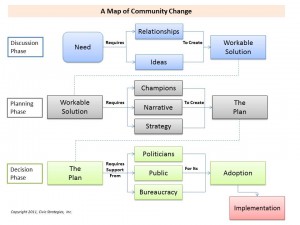I’m beginning a series of short postings about how cities decide things and how leaders can help their communities make smarter decisions. I’m calling these brief essays “Rules for Reformers.” Each will have an illustration, some scribbled key words, or a hand-drawn chart that, I hope, will make the ideas stick a little longer with you. (If the drawings seem a tad childish, feel free to blame the artist, who is . . . me.)
The rules come from conversations I’ve had over the years with civic leaders. The best leaders I’ve known—from mayors and county executives to chamber executives and CEOs—operate mostly from tacit knowledge, a set of understandings about power, change, and human nature that they accumulate over a lifetime and which becomes instinctual. As a result, they know how to get things done, they just can’t explain how they do it, and they certainly can’t teach it. This is fine with me because I’m in the explaining business.
My caution is that this is that these brief postings are meant to be simple, and maybe even overly simple. They’re general rules, not a guide to every circumstance. More than anything else, I hope you’ll turn to them when you’re stuck on a civic problem or obstacle. By reading a few of these rules, you may come across something that helps you figure a way through the problem or around the obstacle.
And about the name . . . Some of you have already figured out it’s a play on the name that the legendary Chicago organizer Saul Alinsky gave to his 1971 book, “Rules for Radicals: A Pragmatic Primer for Realistic Radicals.” I’m not a fan of Alinsky’s or of his book. For one thing, I’m no radical. For another, his book isn’t actually helpful for people wanting to learn about community organizing. It’s more of a collection of war stories with a few philosophical musings (and even a sexist joke) thrown in. But it’s a great name.
So, with apologies to the late Mr. Alinsky, here are my “Rules for Reformers.” I’ll start with a few, add a few more, and we’ll see where things go from there. Please let me know what you think.
Here are the first Rules for Reformers: Three Ps of Public Policy, A Formula for Change and “What” Before “How.” Others will follow.


